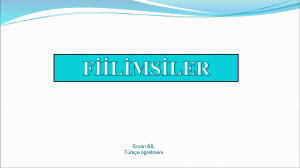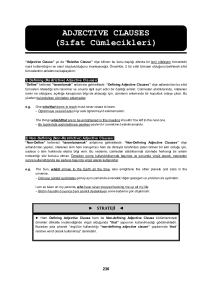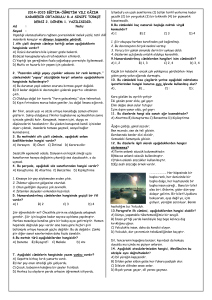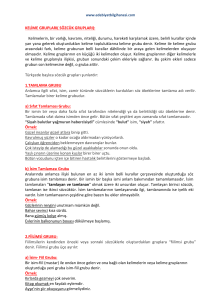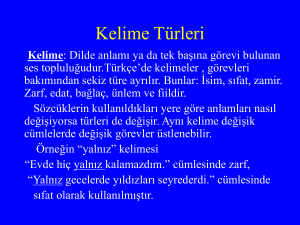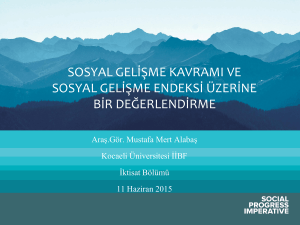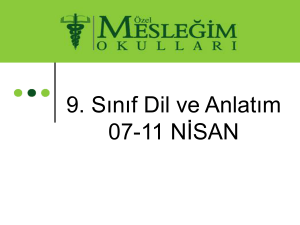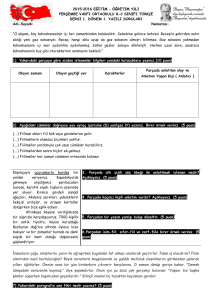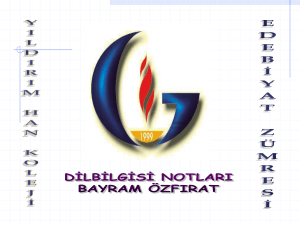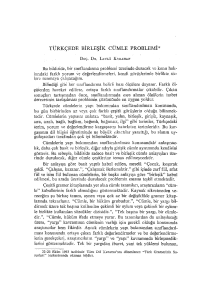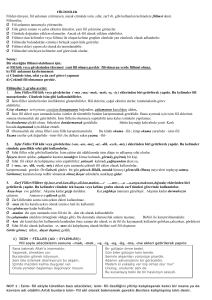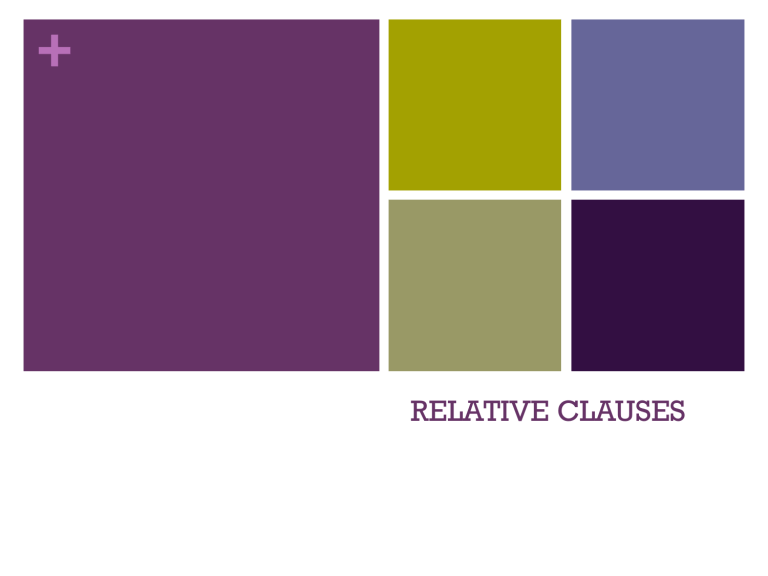
+
RELATIVE CLAUSES
+
Relative (Adjective) Clauses
We use relative clauses to combine two simple sentences in which
there are two identical noun phrases.
Sıfat Cümlecikleri, kendinden önce gelen isim/isim öbeği hakkında
açıklayıcı/niteleyici bilgi veren bir yan cümle türüdür. ( Defining
Relative Clause)
I have a friend who loves penguins.
Penguenleri seven bir arkadaşım var.
Kendinden önce gelen isim/isim öbeği ile ilgili tanımlamada ihtiyaç
duyulmayan, ek bilgi verebilir. ( Non-defining Relative Clause)
Paul Auster, who is my favorite writer, lives in New York.
En sevdiğim yazar Paul Auster New York’ta yaşıyor.
Paul Auster, en sevdiğim yazar, New York’ta yaşıyor.
+
Relative (Adjective) Clauses
Action Verbs in Relative Clauses
I like the girl who is smelling the roses.
Gülleri koklayan kızdan hoşlanıyorum.
State Verbs in Relative Clauses
I like the girl who smells nice.
Güzel kokan kızdan hoşlanıyorum.
She killed the bird which was eating her plants. (action verb)
(O) Bitkilerini yiyen kuşu öldürdü.
She killed the bird which had a blue tail. (state verb)
(O) Mavi kuyruklu kuşu öldürdü.
+
Relative (Adjective) Clauses
Object Relative Clause relative pronoun+noun/pronoun+verb
Mary was the woman who I saw at the cinema.
Sinemada gördüğüm kadın Mary idi.
She killed the bird which her parents gave her.
(O) Anne-babasının ona verdiği kuşu öldürdü.
Subject Relative Clause relative pronoun+verb
Mary was the woman who went to the cinema.
Sinemaya giden kadın Mary idi.
She killed the bird which was eating her plants.
Bitkilerini yiyen kuşu öldürdü.
+
Relative Pronouns
Function
Subjective
For
Defining
People
Things/Animals
Objective
People
Things/Animals
Possessive
People
Things/Animals
Non-Defining
who / that
, who…..,
which / that
, which…..,
who / whom /
that /
,who / whom…,
which / that /
, which…,
whose
,whose….,
whose
, of which…,
, whose…..,
+
Formation of Relative Clauses
Basic Sentences
This is the boy.
Relative Clauses
He kicked me.
• This is the boy who kicked me.
I kicked him.
• This is the boy whom I kicked.
• This is the boy who I kicked.
• This is the boy that I kicked.
• This is the boy I kicked.
His brother
kicked me.
•This is the boy whose brother kicked
me.
I kicked his
brother.
•This is the boy whose brother I kicked.
+
Formation of Relative Clauses
Basic Sentences
This is the
horse.
Relative Clauses
It kicked me.
• This is the horse which kicked me.
I kicked it.
• This is the horse which I kicked.
• This is the horse that I kicked.
• This is the horse I kicked.
Its owner kicked
me.
•This is the horse whose owner kicked
me.
The owner of the
horse kicked me.
•This is the horse, the owner of which
kicked me.
+
Formation of Relative Clauses
Sıfat cümleciğinin tanımladığı isim /isim öbeğine mümkün
olduğunca yakın kullanılması tercih edilir.
The building for sale was the house which had a slate roof
and was by the stream.
The building for sale was the house by the stream which had
a slate roof.
+
Formation of Relative Clauses
Sıfat cümleciğine ilgi zamirine ek olarak özne ya da nesne
eklenemez.
The man who gave me the book was the librarian.
The man who he gave me the book was the librarian.
Konuşma dilinde kullanılmasına rağmen temel cümleye sıfat
cümlesinin yanı sıra bir zamir eklenmesi gereksizdir.
A friend of mine who is a solicitor helped me.
A friend of mine who is a solicitor – she helped me.
+
Relative Adverbs
Although the entire clause introduced by a relative adverb is adjectival, and
functions to modify a noun/pronoun in the main sentence clause; the relative
adverb itself modifies a verb within its own clause.
Place (space)
Time (duration) WHEN
Reason (cause and/or effect)
reason + WHY
reason + THAT
WHERE
İlgi Zarfları sıfat cümleciği içindeki fiili niteleyerek nitelediği fiile zarf özelliği
kazandıran (zarflaştıran) sözcüklerdir. İlgi zarfı yan cümlecikteki fiili
nitelerken sıfat cümleciği bütün olarak önündeki isim ya da zamiri niteler.
The office is the place where you waste most of your time.
These are the times when Joan lost her initiative.
That is the reason why Mark refused to come.
I didn’t get a pay rise, but this wasn’t the reason that I left.
+
Prepositions in Relative Clauses
FORMAL
Preposition + Which / Whom/Whose
Whose Of Which
Edat içeren sıfat cümleciklerinin formal/resmi metinlerinde
kullanılması halinde edat ilgi zamirinin önüne getirilir.
The rate at which a material heats up depends on its chemical
composition.
In the novel by Peters, on which the film is based, the main
character is a teenager.
An actor with whom Gelson had previously worked contacted him
about the role.
I now turn to Freud, from whose work the following quotation is
taken.
+
Prepositions in Relative Clauses
Edattan sonra “whom” yerine “who”, “that” ilgi zamiri ya da “gizli
ilgi zamiri” kullanılamaz.
Is it right that politicians should make important decisions without
consulting to the public to whom they are accountable?
Is it right that politicians should make important decisions without
consulting to the public to who they are accountable?
The valley in which the town lies is heavily polluted.
The valley in that the town lies is heavily polluted.
+
Prepositions in Relative Clauses
INFORMAL
Günlük/konuşma dilinde edatın ilgi zamirinin önünde kullanılması
yerine sıfat cümleciğinin sonuna getirilmesiyle aşırı resmiyetten
kaçınılabilir.
Jim’s musical talent, which he was noted for, had been encouraged
by his parents.
Variations in the Use of Non-Defining Clauses:
A.Quantifiers with Relative Pronouns
Aşağıdaki örneklerde görüldüğü gibi quantifiers( niteleyici sözcükler)
sıfat cümleciğini tanımlamak için relative pronoun (ilgi zamiri) ile
kullanılabilir.
….., a little/ much/ half
.…., one/ two/ three
….., either/ neither/ both
….., each/ some/ a few/ several
….., none/ all/ every one/ most
OF
WHOM….,
WHICH….,
WHOSE….,
1. a) We have two typist.Both of them are quite efficient .
b) We have two typist, both of whom are quite efficient.
2. a) The teacher was praised by the director.Most of his students were
succesfull in the university entrance examination.
b) The teacher , most of whose students were succesful in the university
examination, was praised by the director.
3. a) There are 250 stars in the Milky Way.One of them is our sun.
b) There are 250 stars in Milky Way ,one of which is our sun.
4. a) Space probes send back valuable information.Much of this will require
years to analyze.
b) Space probes send back valuable information , much of which will
require years to analyze.
B. Variations with the Superlative Form
1. a)There are many lakes in Türkiye. The largest of them is Lake Van.
b)There arE many lakes in Türkiye , the largest of which is Lake Van.
2. a)Shakespeare wrote many plays. The most famous of them is Hamlet.
b)Shakespeare wrote many plays, the most famous of which is Hamlet.
3. a)He has three daugthers. The most beautiful of them is the
youngest.
b)He has three daughters , the most beautiful of whom is the
youngest.
C. Nouns before Relative Pronouns / Possession in Things and Animals
Non-defining clauses (tanımlanamayan cümlecikler) sahiplik( iyelik)
durumunu göstermek için sık sık kullanılırlar.
1. a)The house will be repaired. The roof of the house has been damaged in
the storm.
(Ev onarılacak. Evin çatısı fırtınada hasar gördü.
b)The house , the roof of which has been damaged in the storm , will be
repaired.
(Fırtınada çatısı hasar gören ev,tamir edilecek)
2. a)The agreement will end the long running dispute between the two
countries. The details of agreement will be released tomorrow.
b)The agreement , the details of which will be released tomorrow, will end
the long running dispute between the two countries
D. Using “Which” to Modify a Whole Sentence
Bazen relative clause bütün cümleyi tanımlayabilir. Bu durumda relative
sözcüğü olarak sadece “which” kullanılır.Relative clause temel cümlenin
sonuna eklenir ve bir virgülle ayrılır.
1. a)She got a rather low grade on the test.That suprised me.
(Testten çok düşük not aldı. Bu beni şaşırttı.)
b) She got a rather low grade on the test , which suprised me.
(Testten çok düşük bir not aldı ki bu da beni şaşırttı.)
2. a)Ali passed all his exams.This shocked his friends.
b)Ali passaed all his exams , which shocked his friends.
3. a)He blames me for anything.I think this is unfair.
b)He blames me for anything , which i think is unfair.
•Whereby,whereupon,wherein gibi where+preposition’dan oluşan
yapılar vardır.
√ Whereby = by/through/with which
FORMAL:The government is to end the system whereby farmers make
more money from leaving land unplanted than from growing wheat.
INFORMAL:The goverment is to end the system by/in which farmers
make more money from leaving land unplanted than from growing
wheat.
√ Whereupon = after which, as a result of which
FORMAL: The soldiers were suddenly attacked from
behind,whereupon they turned and started firing that direction.
INFORMAL:The soldiers were suddenly attacked from behind after
which they turned and started firing in that direction.
√ Wherein = in which,during which
FORMAL: There was a period of several years wherein the writer was
unable to work at all.
INFORMAL:There was a period of several years in which the writer was
unable to work at all.
Point,position ve situation kelimeleri sıklıkla where ile
kullanılırlar ama stage kelimesi where ya da when ile
kullanılabilir.
∞ I have reached a point where I’m about to retire.
∞ In time we reached a stage where/when we had more black
readers than white ones.
All,everything,nothing gibi zamirlerden ve superlative yapılardan
sonra which yerine that tercih edilir.
» In a big city, you can find everthing that you need.
» This is the best food that ı have ever eaten.
By means of,in the middle of,during, as a result of gibi ilgeç öbekleri
relative pronoundan önce kullanılmalıdır.
∂ He made an important discovery, as a result of which he became
famous all over the world.
∂ The comittee members held a two-hour meeting, during which
they discussed several issues related to the new syllabus.
∂ The device by means of which we can measure the amount of
radioactivity is called a Geiger counter.
Relative Clauselarda what+few/little yapısı şu şekilde kullanılır :
◊ The few friends that he had deserted him >> What few friends he
had deserted him.
◊ The little money that he had was stolen >> What little money he
had was stolen.
DEFINING RELATIVE CLAUSE
(Belirtisiz Sıfat Tamlaması)
Bu tip relative clause hangi sorusuna
cümle olarak cevap verir. Peşinden geldiği
ismi tanımlar. Bu cümlelere ‘tanımlayan
ilgi cümlecikleri’denir.
Bu cümlecik olmadığı zaman cümleyi söyleyenin kastettiği kişi/şey
anlaşılmaz, cümle yarım olur. Bu haliyle relative clause içinde
bulunduğu ana cümlenin vazgeçilmez bir unsurudur. Bundan dolayı
virgül içinde söylenmez.
Relative clause ana cümle içerisindeki niteleyeceği ismin hemen
peşinden gelir ve ondan ( relative clause) sonra ana cümlenin devamı
gelir.
The people who/that own that house are away on holiday.(özne
durumunda+insanlar için)
He was exactly the person (whom/who/that) I want to see.(nesne
konumunda + insanlar için)
The assignment (that/which) the professor gave me was
easy.(nesneler/şeyler için)
Profesörün bana verdiği ödev kolaydı.
Biz sadece The assignment was easy. = Ödev kolaydı.dersek, cümle
net olmaz. Çünkü bizi dinleyen kişi(ler), ‘hangi ödev?’ diye bir soru sorma
ihtiyacı duyarlar. Ancak The assignment (that/which) the professor gave me
was easy. = Profesörün bana verdiği ödev kolaydı. dediğimizde cümle, karşı
taraf için net hale gelmiş demektir ve ‘hangi ödev?’ diye bir soru
sorulmasına gerek kalmaz.
That’s the office where my brother works. (yer bildiren ifadeler için)
in which
which my brother works in
The Renaissance Period when we saw some innovations witnessed
many important events.
in which
(zaman bildiren ifadeler
için)
(which/that) we some innovations in
They are repairing the house whose roof was damaged during the
storm. (aitlik bildiren ifadeler için)
the roof of which was damaged during the storm
NON-DEFINING RELATIVE CLAUSE
(Belirtili Sıfat Tamlaması)
Zaten tanımlanmış, bilinen bir ismi niteleyen cümleye non-defining
relative clause denir. Bu tip cümleler hangi sorusunun cevabını vermez. Bunlar
niteledikleri ismi belirtme vazifesi de yapmazlar. Zaten isim bellidir, relative
clause ‘ların üstlendikleri görev sadece belirli olan ismi biraz daha açıklamak ve
daha fazla bilgi vermektir.
Non -defining relative clause cümleden çıkarılsa bile cümlenin manası
bozulmaz, sadece ek bilgi edinememiş oluruz. Bu yüzden non-defining relative
clause, eğer cümlelerin arasına giriyorsa iki virgülle, cümlenin sonunda yer
alıyorsa bir virgülle temel cümleden ayrılır.
Mr.Smith, who works at the same company as me, is very fond of
children.
I can rely on Mr.Smith, who Works at the same company as me.
Şimdi tanımlayan ve tanımlamayan ilgi cümlecikleri arasındaki farkı iki
örnekle daha iyi anlamaya çalışalım:
1. They congratulated Ernest Hemingway, who had just won the Nobel
Prize.
2. They congratulated the writer who had just won the Nobel Prize.
Birinci cümle, ‘tanımlamayan’ olarak kurulmuştur. Çünkü cümlede sözü
geçen kişi Ernest Hemingway’dir. Kendisi tanınan biri olduğundan, ayrıca
onu tanımlamaya gerek yoktur. Virgülden sonraki kısım, yalnızca ek bir bilgi
vermektedir. Eğer bu cümle ‘tanımlayan’ olarak kurulsaydı, sanki birden
fazla Ernest Hemingway varmış da, biz Nobel Ödülü alan Ernest
Hemingway’den söz ediyormuşuz gibi bir anlam çıkardı. İkinci cümle,
‘tanımlayan’ olarak kurulmuştur. Çünkü cümlede sözü edilen yazarın kim
olduğu belli değildir. Çıkan anlam şudur: Birden fazla yazar var ama onlar,
bu yazarlar içinden Nobel Ödülü alan yazarı kutladılar. Ayrıca bu cümlenin
virgülsüz olduğuna da dikkat ediniz.
The student who don't want to listen to the teacher are making a lot of
noise. (Öğretmeni dinlemek istemeyen öğrenciler çok gürültü yapıyor.)
Bu cümlede anlaşılan şudur ki: öğrencilerin bazıları öğretmeni dinlemek
istemiyorlardır. Fakat öğretmeni dinlemek isteyen de vardır. burada defining
relative clause tarafından nitelenen öğrenciler gürültü yapmaktadır. Diğerleri
ise gürültü yapmamaktadır.
The student, who don't want to listen to the teacher, are making a lot
of noise. (Öğrenciler ki öğretmeni dinlemek istemiyorlar, çok gürültü
yapıyorlar.)
Bu cümlede anlaşılan; bütün öğrenciler öğretmeni dinlemek istememektedir
ve istisnasız hepsi gürültü yapmaktadır.
Non-defining relative
clause ile that hiçbir
durumda kullanılmaz.
Non-defining relative clause kullanabileceğimiz isimleri şu şekilde
gruplandırabiliriz:
a)Proper nouns(özel isimler)
The person who lives above us is engineer.(defining)
Mr.Smith, who lives above us, is engineer(non-defining)
A country which is surrounded by the sea is usually a tourist
attraction.(defining)
Turkey, which is surrounded by the sea on three sides, is of strategic
importance.(non-defining)
b)Nouns with preceding modifiers(başka niteleme sözcükleriyle
tanımlanmış isimler)
A mother who is very permissive with her children doesn’t necessarily
make her a good mother.(defining)
My mother, who lives in German now, was moderatly permissive with
us.(non-defining)
Any bus which comes here already full doesn’t stop at this bus
stop.(defining)
This bus, which usually comes here already full, goes directly to
Kadiköy.(non-defining)
Bir isim kendinden sonra gelen bazı sözcüklerle de tanımlanmış
olabilir.
The man who was working at the shop was friendly.(defining)
The man at the shop, who gave my son a sweet, was friendly.(nondefining)
The table which is in the kitchen needs repairing.(defining)
The table in the kitchen, which we usually have our breakfast on,
needs repairing.(non-defining)
c)Coal, rice, milk, flower, gibi isimler genel anlamda kullanıldığı zaman,
zaten herkesçe bilinen isimler olduğu için, non-defining relative clause
alır.
Flowers, which almost everybody likes, need special care to
grow.(general- non-defining)
The flowers which are sold at that florist’s are usually fresh.(specificdefining)
Milk, which is essential for people of all ages, should be boiled
well.(general- non-defining)
The milk which we get from that dairy is really delicious.(specificdefining)
Özne durumunda, insanlar için sadece who, nesneler için sadece
which kullanabiliriz.
My father lives in Germany. He is over sixty now.
My father, who is over sixty now, lives in Germany.
Our television set has become erratic.It was bought eight years ago.
Our television set, which was bought eight years ago, has become
erratic.
Eğer isim, bir prepositions’ın nesnesi durumunda ise, preposition
relative clause’un sonunda yer alırsa who ya da whom, başında yer alırsa
sadece whom kullanabiliriz. Nesneler için ise yine which kullanılır.
Mr.Smith is an honest person.I’ve been working with him for five years.
Mr.Smith, whom I’ve been working with for five years, is honest person.
, who I’ve been working with for five years, is honest person.
, with whom I’ve been working for five years, is an honest
person.
My car is beginning to cause trouble.I had saved up for it for two years.
My car, which I had saved up for for five years, is beginning to cause
trouble.
, for which I had saved up for two years,
Aitlik bildiren bütün isimler için whose ya da of which
kullanırız.Ancak cansız varlıklar için of which kullanımı pek yaygın
değildir.
Their house cost them too much money. They painted its exterior pink.
Their house, whose exterior they painted pink, cost them too much
money.
,the exterior of which they painted pink,
Possesive durumundaki isme ait bir preposition varsa, bu
preposition’ı whose’un önünde ya da relative clause’un sonunda
kullanabiliriz.
Uludağ is a famous ski resort. You can always see snow on its top.
Uludağ, whose top you can always see snow on, is a famous ski
resort.
, on whose top you can always see snow,
, on the top of which you can always see snow,
Yer bildiren sözcükler için, non-defining relative clause ‘larda da
where kullanabiliriz.
Istanbul has many problems to solve.More ten million people live
there.(in Istanbul)
Istanbul, where more than ten million people live, has many problems
to solve.
, which more than ten million people live in,
,in which more than ten million people live,
Eğer bir yer ismi, tanımlayan cümlede özne ya da nesne
durumundaysa where kullanamayız. Sadece which kullanabiliriz.
Salihli is located in the west of Turkey. It is my hometown.(It – Subject)
Salihli, which is my hometown, is located in the west of Turkey.
Salihli is located in the west of Turkey. I like it very much.(It – Object)
Salihli, which I like very much, is located in the west of Turkey.
Non-defining relative clause’larda, zaman ifade eden sözcükler için
when ya da preposition + which kullanabiliriz.
One of the most important dates in Turkish history is 29
October,1923.The Republic was founded then.(on that date)
One of the most important dates in Turkish history is 29 October,1923,
when/on which the Republic was founded.
My favourite season is spring.Nature awakens with all its lively
colours then.(in spring)
My favourite season is spring, when/in which nature awakens with all
its lively colours.
Süreç bildiren bir zaman zarfını tanımlayan relative clause’larda
preposition + which time kullanılır. Bu tür cümlelerde preposition +
which time yerine when kullanamayız.
The guests arrived at 7 p.m. I had finished all the preparations by then.
The guests arrived at 7 p.m. ,by which time I had finished all the
preparations.
Defining Relative Clause
Non-Defining Relative
Clause
Nitelediği isim hakkında bize tanımlayıcı
ve gerekli bilgi verir.
Nitelediği isim(özel isim,zaten
tanımlanmış bir isim ya da genel
anlamda kullanılan herkesçe bilinen
isim)hakkında fazladan bilgi verir ve
bu bilgi cümlenin anlaşılması için
gerekli değildir.
Who,whom,that,which,whose
Who,whom,which,whose
(that kullanılmaz)
Öznenin yerini tutan ilgi zamirleri
atılamaz,nesnenin yerini tutan ilgi
zamirleri atılabilir. (whose atılamaz)
İlgi zamiri atılamaz.
Sıfat cümleciği virgülle ayrılmaz.
Sıfat cümleciği virgülle ayrılır.
The boy who lost his dog is very sad.
I live in a town which is full of historical
sights.
Marc, who lost his dog, is very sad.
I live in Istanbul, which is full of
historical sights.
Relative Clause,Noun Clause ve Adverbial Clause
Relative Clause’larda kullandığımız that,which,who,when,where
gibi sözcükleri noun clause ve adverb clause ile de kullanabiliriz.
Relative Clause = I don’t know the city where he lives.
(noun) (relative clause)
Noun Clause = I don’t know where he lives.
(verb) (noun clause)
> They got married on a day when I was abroad. Relative Clause
(Benim yurtdışında olduğum bir gün evlendiler.)
> They got married when I was abroad. Adverbial Clause
(Ben yurtdışındayken evlendiler.)
> I don’t remember when they got married. Noun Clause
(Ne zaman evlendiklerini hatırlamıyorum.)
I want to know the students who are coming with us.Relative
Clause
↔ (Bizimle gelecek öğrencileri öğrenmek istiyorum.)
I want to know who are coming with us.Noun Clause
↔ (Bizimle kimlerin geleceğini öğrenmek istiyorum.)
‘’What’ bir isimden sonra gelmez.Genellikle bir fiilden sonra gelir
ya da özne durumundaki bir noun clause’un başında bulunur.
I don’t know what he bought.
(Ne aldığını bilmiyorum.) NOUN CLAUSE
I don’t know the thing that he bought.
(Aldığı şeyi bilmiyorum.) RELATIVE CLAUSE
What he said wasn’t so important.
(Ne dediği o kadar önemli değildi.) NOUN CLAUSE
The thing that he said wasn’t so important.
(Söylediği şey o kadar önemli değildi.) RELATIVE CLAUSE
CLEFT SENTENCES
Cleft sentence’lar cümlenin belirli bir bölümüne odaklanmamıza yardımcı olmak
veya söylemek istediğimiz şeyi vurgulamak amacıyla kullanılırlar.
‘’Serpil sends Ahmet a letter on sundays.’’
1.
2.
3.
4.
Cümlede ‘’a letter’’ kelimesini vurgulamak istiyorsak : It is a letter which
Serpil sends Ahmet on sundays.
Cümlede Serpil’i vurgulamak için : It is Serpil who sends a letter to Ahmet
on sundays.
Cümlede Ahmet’i vurgulamak için : It is Ahmet to whom Serpil sends a
letter on sundays.
Cümlede günü vurgulamak için : It is on sundays when Serpil sends
Ahmet a letter.
Kişileri ya da nesneleri daha specific hale getirmek istersek
cümleyi ‘’the person who’’,’’the thing that’’ gibi kalıplarla da
yazabiliriz.
∞ The thing that is important than anything else is your health.
Vurgu cümlelerinde sebep,yer ya da zaman vurgulanmak
isteniyorsa ‘’the reason why,the place where,the day when’’
gibi kalıplar kullanılabilir.
∞ The reason why I have come is to discuss your decision about
us.
∞ (Buraya gelmemin sebebi bizimle ilgili kararını tartışmak.)
∞ The place where she hides her children is too far way from city.
∞ (Çocuklarını sakladığı yer şehirden çok uzak.)
REDUCTION OF RELATIVE
CLAUSES
(SIFAT CÜMLECİKLERİNİN KISALTILMASI)
Reduction of Relative Clause;
İngilizce’de bir sıfat cümleciğini
(relative clause) anlamını hiç bozmadan,
cümle olmaktan çıkarıp sözcük öbeği
biçiminde kısaltabiliriz.
Kısaltma yaparken cümleden ilgi zamiri(relative
pronoun) atılır ve sıfat cümleciğinin yüklemi,
sıfat cümleciğinin pasif-aktif olmasına, zamanına
veya türüne göre yeniden düzenlenir.
♪ The moneywhich
was stolen from the bank has been
recovered.
♪ The money stolen from the bank has been
recovered.
Ancak bu kısaltmaları yapabilmek için ;
Kısaltma yapacağımız cümledeki ilgi zamirlerinin
“who,which ya da that” olması gerekir!
who
which
that
Ve bu ilgi zamirlerinin sıfat
cümleciğinde “özne” konumunda
bulunması gerekir ama bu kural
yalnızca belirtisiz sıfat
tamlamalarında(defining) geçerlidir.
Çünkü, eğer kısaltma yapılacak olan cümle belirtili
sıfat cümleciğiyse, o zaman kısaltma, cümledeki
ilgi zamiri nesne durumundaysa da yapılabilir.
Cümle
belirtisiz sıfat tamlaması (defining)
konumundayken;
♪ The boy who is running towards us is my son.
(Kısaltma yapılabilir. Cümle belirtisiz sıfat tamlaması
konumunda ve ilgi zamiri özne konumunda)
♪ The boy who you met yesterday is my son.
(Kısaltma yapılamaz. Çünkü cümle belirtisiz sıfat
tamlaması konumundayken ilgi zamiri nesne konumunda)
Cümle
Belirtili sıfat tamlaması ( non-defining)
Konumundaysa;
The boy, who you met yesterday is my son.
(Burda kısaltma yapabiliriz. Çünkü ilgi zamiri nesne konumunda olsa
da, cümle belirtili sıfat tamlaması konumunda.)
Bir sıfat cümleciğini (relative clause) şu şekillerde
kısaltabiliriz:
REDUCTİON OF
RELATIVE
CLAUSES
PRESENT
PARTICIPLE
(-ING)
PAST
PARTICIPLE
PERFECT
PARTICIPLE
(V3)
(HAVING V3)
TO+INFINITIVE
(TO +
V1 )
BE +SIFAT/
EDAT /İSİM
varsa
(İkiside atılır)
resent
articiple
(V+İNG)
İLE…
PRESENT PARTICIPLE (-ING) İLE KISALTMA
Eğer sıfat cümleciğinin zamanı;
Geniş zaman
Geçmiş zaman
İSE,
Şimdiki zaman
Ve cümle AKTİF yapıdaysa
İlgi zamiri atılır ve sıfat
cümleciğinin yükleminin
birinci haline –ing eklenir.
Geçmiş zamanın hikayesi
1.The stadium that seats 50.000 spectators was completed last
year.
1.The stadium seating 50.000 spectators was completed last year.
2.The customer who wanted to see the manager looked very angry.
2.The customer wanting to see the manager looked very angry.
3. Are you the one who is constantly smoking in the living room at
nights?
3. Are you the one constantly smoking in the living room at nights?
4.Her parents,who expect her to get a high grade, will be
disappointed if she can’t.
4.Her parents, expecting her to get a high grade, will be
disappointed if she can’t.
ast
(V3)
articiple
İLE…
PAST PARTICIPLE (V3 ) İLE KISALTMA
Eğer sıfat cümleciğinin zamanı;
İSE,
Ve cümle PASİF yapıdaysa
Geniş zaman
Geçmiş zaman
Yakın geçmiş zaman
(present perfect tense)
Geçmiş zamanın rivayeti
(past perfect tense)
İlgi zamiri atılır ve sıfat
cümleciğinin yükleminin 3.
hali yazılır.
1.The girl who is married to a tycoon is very happy.
1.The girl married to a tycoon is very happy.
2. The photographs which were published in the magazine were
conspicuous.
2.The photographs published in the magazine were conspicuous.
3.The points which have been raised at the meeting are quite
relevant.
3.The points raised at the meeting are quite relevant.
4 .The method which had been used in India would be very
successful.
4.The method used in India would be very successful.
Pasif yapıdaki şimdiki zaman (Present Continuous )ve
geçmiş zamanın hikayesi(Past Continuous) cümlelerinin
kısaltılması;
Sıfat cümleciklerinde kısaltma
yaparken normalde “being” kullanılmaz.
Fakat continuous tense’lerle pasif
eylem kullanılmışsa, eylemin sürerlik
bildirdiğini belirtmek için “being”
pasif yapıda olduğunu belirtmek için “V3 “
kullanırız.
ilgi zamiri atılır
being
(V3)
eklenir
Everybody was captured by the charm of the music which was
being played so beautifully by the orchestra.
Everybody was captured by the charm of the music being played
so beautifully by the orchestra.
The patient who is being examined by the doctor is very ill.
The patient being examined by the doctor is very ill.
The car which is being washed is very expensive.
The car being washed is very expensive.
The term which is currently being discussed at the board
meeting was added to the agenda at the last moment.
The term currently being discussed at the board meeting
was added to the agenda at the last moment.
erfect
articiple
İLE…
Sıfat cümleciğinin yüklemiyle ana cümlenin yüklemi arasında zaman farkı
varsa, sıfat cümleciğine geçmiş vurgusu yapabiliriz.
AKTİFSE
having
PASİFSE
V3
Eğer sıfat cümleciğinin yapısı
“aktifse” ;
İlgi zamiri atılır.
having eklenir.
Fiil 3. haline
getirilir.
having
been
V3
Eğer sıfat cümleciğinin yapısı
“pasifse” ;
İlgi zamiri atılır.
having been eklenir
Fiil 3. haline
getirilir.
AKTİF CÜMLELERDE;
The students who failed the Math course have to take it
again next term.
Ana fiil : has to take (geniş zaman)
Sıfat C. Filli : failed (geçmiş zaman)
Burdaki zaman farkını belirtmek için kısaltma yapabiliriz.
Şu şekilde olur:
The students having failed the Math course has to take it
again next term.
The child who had an terrible accident is in a hospital now.
The child having had an terrible accident is in a hospital now.
PASİF CÜMLELERDE;
Murat, who had been fired, looked for another job for five
months .
Murat, having been fired, looked for another job for five months.
She is the child who was grown by her grandmother.
She is the child having been grown by her grandmother.
The baby who was found in the park is in the police office now.
The baby having been found in the park is in the police office
now.
Guests that had been invited before were absent in the
conference last night.
Guests having been invited before were absent in the conference
last night.
O
nfinitive
İLE…
Aşağıdaki yapılardan sonra kısaltmamızı to infinitive kullanarak yaparız.
To infinitive
Sıra sayı
sıfatları
The only
En üstünlük
zarfları
kipler
Belgisiz
zamir
Sıfat cümleciğinde bu yapılar kullanıldığında (sıra sayı sıfatı,en
üstünlük zarfları,the only,kipler,belgisiz zamir); bunlardan sonra
“ilgi zamiri ve eğer varsa yardımcı fiil atılır,
Aktif ise
Pasif ise
To +
To+ be +
V1
V1
EKLENİR”
Sıra sayı sıfatlarından sonra(the first,the second,the
last, the next vb.) ;
Neil Armstrong was the first man who set foot on the moon.
Neil Armstrong was the first man to set foot on the moon.
(AKTİF)
The last person that can be appointed to investigate these
complaints is Mr. Jackson.
The last person to be appointed to investigate these complaints
is Mr. Jackson.
(PASİF)
The only’den sonra;
The only man that was seen there that day was Mr Smith.
The only man to be seen there that day was Mr Smith.
(PASİF)
Nazan was the only student who hadn’t done her homework.
Nazan was the only student not to have done her homework.
(AKTİF)
En üstünlük zarflarından sonra ( superlatives);
Ali is the strongest contestant who takes part in this
competition.
Ali is the strongest contestant to take part in this
competition.
(AKTİF)
It was the best route that could be followed at that time.
It was the best route to be followed at that time.
(PASİF)
Kiplerden sonra (modal verbs) ;
A person who can kill an animal for pleasure is ruthless.
A person to kill an animal for pleasure is ruthless.
(AKTİF)
Today, I will have many work that must be done.
Today, I will have many work to be done.
(PASİF)
Belgisiz zamirlerden sonra (something, someone, anything,
anybody vb.)
It’s cold outside. I need something that I can put on.
It’s cold outside. I need something to put on.
There was nothing that we could eat.
There was nothing to eat.
Ayrıca kısaltma yaparken to infitive yapısını şu
şekilde de kullanabiliriz;
To + infinitive ayrıca amaç belirtmek için kullanılır. Bu
durumda in order to / so as to vb. amaç bildiren yapılar
to + infinitive’e eşittir ve Türkçe’ye “için” olarak çevrilir.
He needs to study hard in order to improve his speaking
skill.
He needs to study hard to improve his speaking
skill.
She got up early so as to have time to pack.
She got up early to have time to pack.
e
ıfat
dat
sim
Sıfat cümleciğinde kısaltma yaparken “to be” (am, is, are, was,
were, been) den sonra bir “edat” (in, at, on) geliyorsa ilgi zamiri ve
to be filli atılır.
The people who were
along both sides of the road were watching
the parade.
The people along both sides of the road were watching the parade.
My nightingale, which is in the cage, sings beautifully all the time.
My nightingale, in the cage, sings beautifully all the time.
The poor cat that is across the road needs feeding.
The poor cat across the road needs feeding.
Sıfat cümleciğinde kısaltma yaparken “to be” (am, is, are, was,
were, been) den sonra bir “sıfat” ya da “sıfat tamlaması”
geliyorsa ilgi zamiri ve to be filli atılır.
Cigarette which is bad for one’s health should be avoided.
Cigarette bad for one’s health should be avoided.
Ankara, that is
the capital city of Turkey, is also a major
trade center.
Ankara, the capital city of Turkey, is also a major trade
center.
The children who were happy about the picnic were full of
excitement.
The children happy about the picnic were full of excitement.
Sıfat cümleciğinde kısaltma yaparken “to be” (am, is,
are, was, were, been) den sonra bir “isim” ya da “isim
tamlaması” geliyorsa ilgi zamiri ve to be filli atılır.
Bunu genellikle tanımsız(non-defining) sıfat
cümleciklerinde kullanırız.
Mr. Clark,
who is
a farmer, has many goats.
Mr. Clark, a farmer, has many goats.
The mammoth, that are a kind of elephant, are
extinct animals.
The mammoth, a kind of elephant, are extinct animals.
References
•
•
•
•
•
•
•
•
•
•
•
•
Öztürk C, (1994) Building Skills For Proficiency Ankara; Hacettepe-Taş
Vince M, (2008) Macmillan English Grammar in Context Oxford; Macmillan
Hewings M, (1999) Advanced English Grammar in Use Cambridge; Cambridge University
Press
Değirmenci İ, Şahsuvar D, Grammar Book1 Dilko
ELS
Azar B, Understanding&Using English Grammar Prentice Hall Regents
www.kpds.org
www.rainschool.com
http://www.scribd.com/doc/2561946/RELATIVE-CLAUSES
http://www.englishlanguageguide.com/english/grammar/relative-pronoun.asp
www.esl-lounge.com
www.testyourenglish.net

